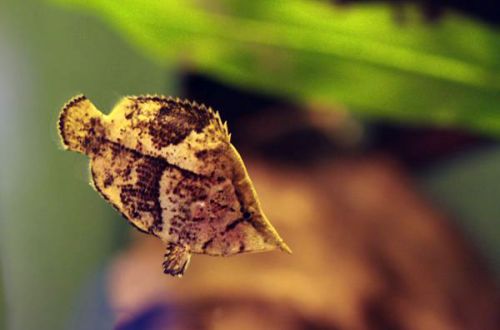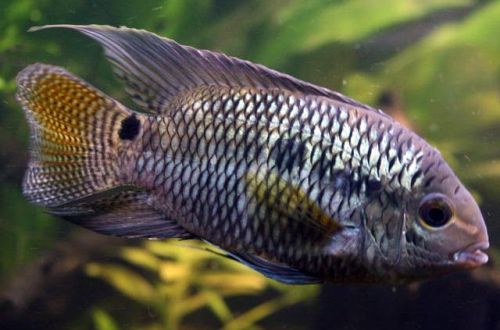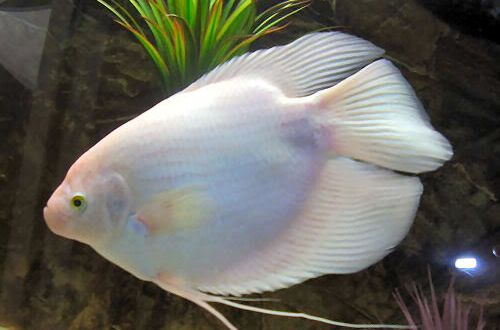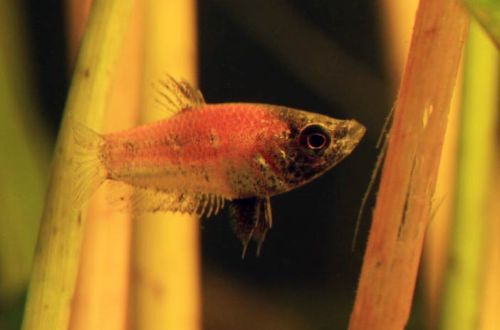
Fish-leaf
The leaf fish, scientific name Monocirrhus polyacanthus, belongs to the Polycentridae family. It has an amazing adaptation – disguise as fallen leaves, which allows you to discreetly watch for the victim and eat it. A very interesting representative of the labyrinths, however, a special diet makes it very difficult to keep in a home aquarium, since it is difficult to ensure the presence of live fish for feeding. It is not recommended for beginner aquarists, not only because of the diet, but also because of the high requirements for water quality.

Contents
Habitat
It comes from South America from the territory of modern Brazil, Peru, Venezuela, Colombia and Bolivia. It lives in numerous river systems among tropical forests. Prefers shallow water regions with a slow current and numerous snags and fallen leaves.
Brief information:
- The volume of the aquarium – from 70 liters.
- Temperature – 23-29°C
- Value pH — 5.0–6.8
- Water hardness – soft (1-10 dGH)
- Substrate type – any dark
- Lighting – subdued
- Brackish water – no
- Water movement is very weak
- The size of the fish is up to 10 cm.
- Food – live fish
- Temperament – inhospitable
- Keeping alone or in pairs male / female
Description
Adult individuals reach a length of about 10 cm. The appearance is very specific and is associated with a highly specialized predatory lifestyle. The narrow yellowish-brown body in shape and pattern resembles a dried leaf of a tree.
Food
Predator that feeds on small fish. The hunting method is unique, this species not only looks like a fallen leaf of a tree, but also imitates its drifting movement in the water. Leaf fish lie in wait for prey, hovering at an angle near snags, or slowly swaying like fallen leaves, floating downstream to a school of unsuspecting small fish. When they approach a sufficient distance, a lightning attack occurs – the special design of the jaws allows you to literally swallow the unfortunate victim.
Predatory instincts are very strong and the Leaf Fish will not accept alternative foods other than live fish, such as fast breeding Guppies and some other viviparous species. He eats one or two fish a day.
Maintenance and care, arrangement of the aquarium
The recommended volume of the tank for one fish starts from 70 liters. Particular attention should be paid to the design, which must contain snags in the form of tree roots or branches, plants with broad leaves such as Echinodorus and several clusters of floating vegetation. The substrate is dark.
As an addition, the bottom can be covered with fallen tree leaves, which are pre-dried and then soaked in water for several days until they sink. Replace once every one or two weeks.
Other important requirements include: subdued light levels, minimal water movement, acidic pH values with low carbonate hardness. Equipment is selected and configured based on these requirements.
Behavior and Compatibility
Despite its predatory lifestyle, the Leaffish cannot stand up for itself in the company of large fish due to its modest size. The most preferred species aquarium is inhabited exclusively by representatives of the same species. As neighbors, only representatives of catfish can be considered, for example, Farlovell or Leopard catfish.
Breeding / breeding
The appearance of offspring is quite possible in the general aquarium, provided there are thickets of broad-leaved plants in very soft and acidic water with dim lighting. However, growing fry is not an easy task. With the beginning of the mating season, the males intensify the color, and the females become noticeably rounder. Spawning is accompanied by a kind of dancing, when the fish circle near the surface next to each other until the female decides to lay eggs. The clutch is formed under the surface of a wide leaf, all can be laid up to 300 eggs. The male takes over the protection and care of the clutch.
The fry appear within 3-4 days. As you get older, your diet should change. Start with brine shrimp and daphnia, and then live fry of other fish should be served. It is easier to organize feeding in a separate tank, rather than in the main aquarium. In addition, water quality is of great importance, which is rapidly declining due to the remnants of the meal of fry. Those who plan to start breeding Leaffish will have to solve the problems of constant access to live food and maintaining clean water.
Fish diseases
The main cause of most diseases is unsuitable living conditions and poor-quality food. If the first symptoms are detected, you should check the water parameters and the presence of high concentrations of hazardous substances (ammonia, nitrites, nitrates, etc.), if necessary, bring the indicators back to normal and only then proceed with treatment. Read more about symptoms and treatments in the Aquarium Fish Diseases section.





